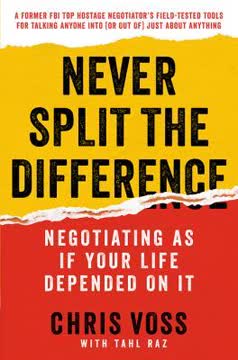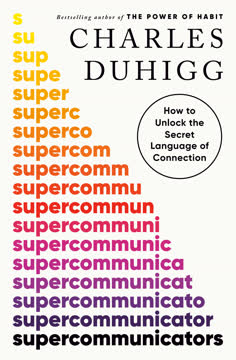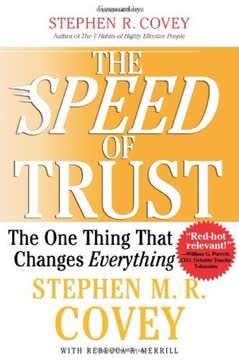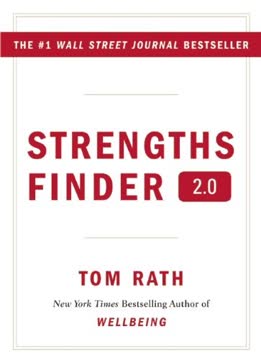نکات کلیدی
1. شناسایی و مدیریت گفتگوهای حیاتی برای بهبود روابط و نتایج
"زمانی که stakes بالا است، نظرات متفاوت است و احساسات به شدت بالا میرود، گفتگوهای عادی به گفتگوهای حیاتی تبدیل میشوند."
گفتگوهای حیاتی بحثهایی هستند که stakes بالایی دارند، نظرات متفاوتی وجود دارد و احساسات قوی در آنها دخیل است. این گفتگوها میتوانند تأثیر قابل توجهی بر زندگی شخصی و حرفهای ما بگذارند. مثالهایی از این گفتگوها شامل بحث در مورد مسائل رابطهای، ارائه بازخورد به همکاران یا پرداختن به موضوعات حساس با اعضای خانواده است. بیشتر افراد یا از این گفتگوها اجتناب میکنند یا بهطور نامناسبی آنها را مدیریت میکنند که منجر به نتایج منفی میشود.
با تسلط بر گفتگوهای حیاتی، میتوانیم:
- روابط را بهبود بخشیم
- چشماندازهای شغلی را افزایش دهیم
- سلامت شخصی را تقویت کنیم
- جوامع را احیا کنیم
کلید کار شناسایی زمانی است که یک گفتگو به گفتگوهای حیاتی تبدیل میشود و به کارگیری مهارتهای خاص برای مدیریت مؤثر آن. این شامل حفظ گفتوگو، ایجاد امنیت و تشویق جریان آزاد اطلاعات است.
2. با قلب شروع کنید: بر آنچه واقعاً از گفتگو میخواهید تمرکز کنید
"بهترینها در گفتگو هم کاملاً صریح و هم کاملاً محترم هستند."
با قلب شروع کنید به معنای تمرکز بر اهداف واقعی شما برای گفتگو است، نه اینکه درگیر پیروزی در بحثها یا اثبات نظرات شوید. این رویکرد به حفظ احترام و باز بودن کمک میکند، حتی در بحثهای چالشبرانگیز.
برای شروع با قلب:
- از خود بپرسید: "واقعاً چه چیزی برای خودم، دیگران و رابطهام میخواهم؟"
- از انتخابهای فریبنده (معضلات کاذب) اجتناب کنید
- بر گفتوگو تمرکز کنید، نه اینکه به دنبال نتیجه خاصی باشید
با روشن کردن نیتهای واقعی خود، احتمال بیشتری وجود دارد که به گفتگو بهطور سازنده نزدیک شوید و راهحلهای متقابل سودمند پیدا کنید.
3. یاد بگیرید که نگاه کنید: شناسایی زمانی که امنیت در یک گفتوگو در خطر است
"اولین شرط امنیت، هدف مشترک است."
یاد بگیرید که نگاه کنید به معنای شناسایی نشانههایی است که نشان میدهد یک گفتگو در حال تبدیل شدن به یک گفتوگوی ناامن است. این مهارت بسیار مهم است زیرا زمانی که افراد احساس ناامنی میکنند، معمولاً به سکوت (نگهداشتن اطلاعات) یا خشونت (سعی در تحمیل نظرات خود به دیگران) روی میآورند.
نشانههای کلیدی که باید به آنها توجه کنید:
- نشانههای فیزیکی: سرخ شدن، گره کردن مشتها
- نشانههای احساسی: احساس آسیب، خشم یا ترس
- نشانههای رفتاری: بالا بردن صدا، قطع کردن صحبت، کنارهگیری
با شناسایی این نشانهها در مراحل اولیه، میتوانید اقداماتی برای بازگرداندن امنیت و حفظ گفتوگو بهصورت سازنده انجام دهید. این ممکن است شامل روشن کردن نیتها، اذعان به نگرانیهای دیگران یا پیدا کردن یک هدف مشترک باشد.
4. امنیت را ایجاد کنید: فضایی را فراهم کنید که گفتوگوی باز بتواند شکوفا شود
"گفتوگو جریان آزاد معنا بین دو یا چند نفر است."
ایجاد امنیت به معنای فراهم کردن شرایطی است که افراد احساس راحتی کنند تا افکار و احساسات صادقانه خود را به اشتراک بگذارند. این شامل ایجاد هدف مشترک (توافق بر روی یک هدف مشترک) و احترام متقابل (ارزشگذاری یکدیگر به عنوان انسان) است.
تکنیکهای ایجاد امنیت:
- در صورت لزوم عذرخواهی کنید
- برای روشن کردن نیتها تضاد ایجاد کنید (آنچه که منظور شما نیست در مقابل آنچه که منظور شماست)
- اگر هدف مشترکی وجود ندارد، یک هدف مشترک ایجاد کنید
زمانی که افراد احساس امنیت کنند، احتمال بیشتری وجود دارد که در گفتوگوی باز و صادقانه شرکت کنند که منجر به درک و نتایج بهتر میشود.
5. داستانهای خود را تسلط کنید: احساسات خود را با بررسی افکارتان کنترل کنید
"احساسات بر شما نمینشینند مانند مه. آنها به شما تحمیل نمیشوند. فقط شما و تنها شما احساسات خود را ایجاد میکنید."
تسلط بر داستانهای خود به معنای شناسایی این است که احساسات ما از داستانهایی که درباره رویدادها برای خود تعریف میکنیم ناشی میشود، نه خود رویدادها. با بررسی و تغییر این داستانها، میتوانیم بهتر بر واکنشهای احساسی خود کنترل داشته باشیم.
مراحل تسلط بر داستانهای خود:
- رفتار خود را مشاهده کنید (آیا در سکوت یا خشونت هستید؟)
- با احساسات خود ارتباط برقرار کنید
- داستانهای خود را تحلیل کنید
- واقعیت را از داستان جدا کنید
- به دنبال داستانهای "قربانی"، "شرور" و "بیچاره" باشید
با به چالش کشیدن تفسیرهای اولیه خود و در نظر گرفتن توضیحات جایگزین، میتوانیم به گفتگوهای حیاتی بهطور منطقی و سازنده نزدیک شویم.
6. مسیر خود را بیان کنید: نظرات خود را به گونهای بیان کنید که درک متقابل را تشویق کند
"بهترینها در گفتگو نظرات خود را بهطور کامل بیان میکنند و این کار را به گونهای انجام میدهند که برای دیگران ایمن باشد تا آنچه را که میگویند بشنوند و به آن پاسخ دهند."
STATE یک اختصار است که چارچوبی برای بیان مؤثر نظرات شما فراهم میکند:
- حقایق خود را به اشتراک بگذارید
- داستان خود را بگویید
- از دیگران درباره مسیرهایشان بپرسید
- بهطور محتاط صحبت کنید
- آزمایش را تشویق کنید
این رویکرد به شما کمک میکند تا دیدگاه خود را بهوضوح ارائه دهید در حالی که به نظرات دیگران نیز باز میمانید. با به اشتراک گذاشتن حقایق در ابتدا و اذعان به اینکه تفسیر شما فقط یک داستان است، دیگران را دعوت میکنید تا دیدگاههای خود را به اشتراک بگذارند و منجر به گفتوگویی متعادلتر شوید.
7. مسیرهای دیگران را بررسی کنید: بهطور فعال گوش دهید و دیدگاههای مختلف را درک کنید
"بهترینها در گفتگو کاری کاملاً متفاوت انجام میدهند. آنها هم کاملاً صریح و هم کاملاً محترم هستند."
بررسی مسیرهای دیگران به معنای جستجوی فعالانه برای درک دیدگاههای دیگران است، بهویژه زمانی که با دیدگاههای شما متفاوت است. این مهارت برای ایجاد درک متقابل و یافتن راهحلهایی که برای همه کارساز باشد، بسیار مهم است.
تکنیکهای بررسی مسیرهای دیگران:
- از دیگران بپرسید تا گفتگو را آغاز کنید
- احساسات را تأیید کنید
- داستان را با پارافریز کردن تأیید کنید
- زمانی که به جایی نمیرسید، پیشفرض بگذارید
با جستجوی واقعی برای درک دیگران، احترام را نشان میدهید و فضایی را ایجاد میکنید که در آن حل خلاقانه مشکلات میتواند شکوفا شود.
8. به عمل بروید: گفتوگو را به نتایج تبدیل کنید از طریق تصمیمگیریهای واضح و پیگیری
"برای اینکه یک ایده خوب پذیرفته شود، باید از دو افراط اجتناب کنید: (1) اجتناب به هر قیمتی و (2) غوطهور شدن بهطور سرسخت."
به عمل رفتن به معنای تبدیل بینشهای بهدستآمده از گفتوگو به نتایج ملموس است. این نیاز به وضوح در مورد فرآیندهای تصمیمگیری و اقدامات پیگیری دارد.
مراحل کلیدی برای به عمل رفتن:
- تصمیم بگیرید که چگونه تصمیم بگیرید (فرمان، مشاوره، رأیگیری یا توافق)
- تصمیمات و وظایف را مستند کنید
- بر روی تعهدات پیگیری کنید
با تعریف واضح مراحل بعدی و مسئولیتها، اطمینان حاصل میکنید که بینشهای ارزشمندی که از گفتگوهای حیاتی بهدست آمدهاند، به تغییرات معنادار و نتایج بهبود یافته تبدیل میشوند.
آخرین بهروزرسانی::
FAQ
What's "Crucial Conversations" about?
- Core Focus: "Crucial Conversations" by Kerry Patterson, Joseph Grenny, Ron McMillan, and Al Switzler is about mastering the skills needed to handle high-stakes, emotional, and controversial conversations effectively.
- Key Concept: The book introduces the concept of dialogue as the free flow of meaning between two or more people, which is essential for making better decisions and achieving desired results.
- Practical Tools: It provides practical tools and techniques to help individuals stay in dialogue, even when emotions run high, and to ensure that all relevant information is shared openly.
- Real-Life Applications: The authors use real-life examples and research to illustrate how these skills can be applied in various settings, from personal relationships to professional environments.
Why should I read "Crucial Conversations"?
- Improve Communication: The book offers valuable insights into improving communication skills, which are crucial for personal and professional success.
- Handle Difficult Situations: It equips readers with the tools to handle difficult conversations that could otherwise lead to misunderstandings or conflicts.
- Enhance Relationships: By learning to communicate effectively, readers can strengthen their relationships and build trust with others.
- Achieve Better Outcomes: The skills taught in the book can lead to better decision-making and more positive outcomes in both personal and organizational contexts.
What are the key takeaways of "Crucial Conversations"?
- Start with Heart: Focus on what you really want for yourself, others, and the relationship, and avoid making Sucker's Choices.
- Learn to Look: Be aware of when a conversation becomes crucial and watch for signs of safety problems, such as silence or violence.
- Make It Safe: Use techniques like apologizing, contrasting, and finding mutual purpose to restore safety in a conversation.
- Master My Stories: Recognize and control the stories you tell yourself to manage your emotions and stay in dialogue.
How does "Crucial Conversations" define dialogue?
- Free Flow of Meaning: Dialogue is defined as the free flow of meaning between two or more people, which is essential for effective communication.
- Shared Pool of Meaning: The goal of dialogue is to create a shared pool of meaning, where all relevant information is openly shared and understood.
- Safety and Respect: Dialogue requires a safe environment where individuals feel respected and are willing to share their thoughts and feelings.
- Foundation for Success: Effective dialogue is the foundation for making better decisions and achieving successful outcomes in both personal and professional settings.
What is the "Start with Heart" principle in "Crucial Conversations"?
- Focus on Goals: The principle emphasizes focusing on what you really want for yourself, others, and the relationship during a crucial conversation.
- Avoid Sucker's Choices: It advises against making Sucker's Choices, which are false dichotomies that force you to choose between two undesirable options.
- Self-Reflection: Encourages self-reflection to understand your motives and ensure they align with your true goals.
- Maintain Dialogue: By starting with heart, you can maintain dialogue and avoid getting sidetracked by emotions or defensiveness.
How can I "Make It Safe" during a crucial conversation?
- Apologize When Necessary: Offer a sincere apology if you've violated respect or trust, to help restore safety.
- Use Contrasting: Clarify what you don't mean and what you do mean to prevent misunderstandings and reduce defensiveness.
- Find Mutual Purpose: Work to identify a shared goal or interest that both parties can agree on, to create a foundation for dialogue.
- Build Mutual Respect: Ensure that the other person feels respected and valued, which is essential for maintaining a safe environment for dialogue.
What are "Sucker's Choices" and how do they affect conversations?
- False Dichotomies: Sucker's Choices are either/or choices that suggest you must choose between two undesirable options, often leading to poor decision-making.
- Limit Dialogue: They limit dialogue by making it seem like there are no other options, which can lead to silence or violence.
- Avoidance Strategy: People use Sucker's Choices to justify avoiding difficult conversations or to rationalize aggressive behavior.
- Finding the "And": The book encourages finding the "And" by looking for creative solutions that satisfy both sides, rather than settling for a Sucker's Choice.
How does "Crucial Conversations" suggest handling strong emotions?
- Master My Stories: Recognize that your emotions are driven by the stories you tell yourself, and learn to control these stories to manage your emotions.
- Retrace Your Path: Analyze your Path to Action by identifying your feelings, the story behind them, and the facts that support the story.
- Tell the Rest of the Story: Challenge your initial story by considering other possible explanations and focusing on what you really want.
- Stay in Dialogue: By managing your emotions, you can stay in dialogue and avoid reacting with silence or violence.
What role does "Mutual Purpose" play in crucial conversations?
- Foundation for Dialogue: Mutual Purpose is the entry condition for dialogue, ensuring that both parties are working toward a common goal.
- Builds Trust: It helps build trust and respect, as both parties feel that their interests and values are being considered.
- Restores Safety: When safety is at risk, finding a Mutual Purpose can help restore it and keep the conversation on track.
- Encourages Collaboration: By focusing on a shared goal, both parties are more likely to collaborate and find a solution that satisfies everyone.
How can I "Explore Others' Paths" in a conversation?
- Ask for Their Views: Invite others to share their thoughts and feelings by asking open-ended questions and showing genuine interest.
- Mirror Their Emotions: Reflect back the emotions you observe to show empathy and encourage them to open up.
- Paraphrase Their Story: Restate what you've heard to confirm your understanding and demonstrate that you're listening.
- Prime When Necessary: If others are reluctant to share, offer a guess about what they might be thinking or feeling to encourage them to speak.
What are some of the best quotes from "Crucial Conversations" and what do they mean?
- "Start with Heart": This quote emphasizes the importance of focusing on your true goals and maintaining dialogue, even when emotions run high.
- "When it's safe, you can say anything": Highlights the importance of creating a safe environment for open and honest communication.
- "The Pool of Shared Meaning is the birthplace of synergy": Suggests that when all relevant information is shared, it leads to better decision-making and collaboration.
- "People who are skilled at dialogue do their best to make it safe for everyone to add their meaning to the shared pool": Encourages creating an environment where everyone feels comfortable sharing their thoughts and ideas.
How can I apply the skills from "Crucial Conversations" in real life?
- Practice Regularly: Use everyday situations to practice the skills, starting with less risky conversations and gradually moving to more challenging ones.
- Seek Feedback: Discuss your progress with a trusted friend or colleague and ask for feedback on your communication skills.
- Reflect on Experiences: After each crucial conversation, reflect on what went well and what could be improved, and adjust your approach accordingly.
- Stay Committed: Continuously work on enhancing your dialogue skills, as they are essential for personal and professional success.
نقد و بررسی
کتاب گفتوگوهای حیاتی به خاطر بینشهای عملیاش در زمینهی ارتباط مؤثر، تحسینهای زیادی را به خود جلب کرده است. خوانندگان از ابزارهای ارائهشده برای مدیریت بحثهای عاطفی و تأکید بر ایمنی و هدف مشترک قدردانی میکنند. بسیاری این کتاب را برای تعاملات شخصی و حرفهای خود تحولآفرین یافتهاند. برخی به سبک کتاب اشاره میکنند که ممکن است شبیه تبلیغات تلویزیونی باشد، اما اکثر افراد بر این باورند که محتوای آن بینظیر است. منتقدان به مفاهیمی مانند "ایمن کردن فضا" و تمرکز بر نتایج مطلوب اشاره میکنند. چند نفر نیز به بازخوانی کتاب برای بهبود کاربرد آن اشاره کردهاند. بهطور کلی، این کتاب بهطور گستردهای برای بهبود مهارتهای ارتباطی توصیه میشود، هرچند برخی آن را ابتدایی یا گیجکننده میدانند.
Similar Books














